
Unearthing Weaknesses in Building Practices in the Philippines: A Guaranteed Closer Look
The Philippines, an archipelago of over 7,000 islands in Southeast Asia, is a nation known for its rich culture, stunning landscapes, and resilient people. However, beneath its picturesque façade lies a complex issue that has plagued the nation for decades: weaknesses in building practices.
This article aims to shed light on the various challenges, vulnerabilities, and shortcomings in the construction industry in the Philippines, which have significant implications for the safety and well-being of its citizens.
- Poor Infrastructure and Planning
One of the most glaring weaknesses in building practices in the Philippines is inadequate infrastructure and urban planning. Many buildings and structures are constructed without proper zoning and land-use regulations, leading to haphazard urbanization.
This lack of planning not only creates congestion and poor traffic management but also endangers the structural integrity of buildings due to their proximity to hazardous zones, such as flood-prone areas and fault lines.
- Inconsistent Building Codes and Regulations
While the Philippines does have building codes and regulations in place, enforcement is often inconsistent and lax. This results in a wide range of structural quality in buildings across the country.
Corruption within the construction industry can also lead to substandard materials being used, compromising the safety of structures and those who occupy them.
- Vulnerability to Natural Disasters
The Philippines is situated in a region prone to natural disasters, including typhoons, earthquakes, and volcanic eruptions. Despite this, many buildings lack adequate design features and materials to withstand these hazards.
This vulnerability was tragically demonstrated during the destruction caused by Super Typhoon Haiyan in 2013, which claimed thousands of lives and caused massive damage to infrastructure.
- Informal Settlements and Slums
Rapid urbanization and population growth have led to the proliferation of informal settlements and slums in urban areas. These dwellings are often constructed without adherence to any safety or building standards.
As a result, residents in these areas face extreme risks during natural disasters, with poorly constructed buildings being highly susceptible to collapse.
- Lack of Professional Training and Education
The construction industry in the Philippines faces a shortage of trained professionals, including architects and engineers.
Many builders and contractors do not have the necessary skills or knowledge to ensure safe and resilient construction. This deficiency in expertise contributes to the prevalence of substandard buildings.
- Corrosion and Poor Maintenance
Corrosion is a significant issue for structures in the Philippines, particularly those located near the coast or in humid areas. Lack of proper maintenance practices further exacerbates this problem, leading to structural weaknesses over time.
The long-term effects of corrosion can compromise the integrity of buildings, bridges, and other infrastructure.
- Inadequate Building Materials
The use of substandard building materials is a widespread issue in the Philippines. This practice is often driven by cost considerations, as low-quality materials are more affordable.
However, these materials have a shorter lifespan and are more susceptible to damage from natural disasters, making them a significant safety risk.
- Socioeconomic Disparities
Building practices in the Philippines also reflect the country’s socioeconomic disparities. Wealthier individuals and corporations can afford to construct safer and more resilient buildings, while those with fewer resources often settle for substandard structures.
This disparity in building quality further exacerbates the risks faced by vulnerable communities.
Conclusion
Weaknesses in building practices in the Philippines are deeply rooted and multifaceted, stemming from poor infrastructure planning, inconsistent regulations, vulnerability to natural disasters, lack of professional training, and socioeconomic disparities. Addressing these issues requires a concerted effort from government authorities, the construction industry, and civil society.
Improved urban planning, stricter enforcement of building codes, investments in education and professional training, and measures to reduce corruption are all critical steps toward building a safer and more resilient built environment in the Philippines.
Only through these collective efforts can the nation protect its citizens and secure a more stable future for generations to come.
To see other material construction prices, please see here.
To know other construction guides, tips, and methodology for beginners, veterans, and contractors, please see here.
